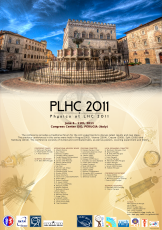Polina Otiougova
(University of Zurich)
09/06/2011, 17:00
We present the measurements of b-quark production in inclusive channels and exclusive decays. The measurements are based on different methods, such as inclusive jet measurements with secondary vertex tagging or selecting a sample of events containing jets and at least one muon. In addition, measurements of B+, B0 and Bs meson production cross sections are presented. Finally, a study of the...
Jure Drobnak
(Jozef Stefan Institute)
09/06/2011, 17:20
Precise measurements of the top quark decay properties at hadron colliders offer interesting new possibilities of testing the standard model. At the same time, recent intriguing experimental results concerning CP violation in the Bd and Bs systems have stimulated many studies of physics beyond the standard model. We investigate anomalous tWdj interactions as a possible source of new effects in...
Cynthia Hadjidakis
(INP and University Paris-sud)
09/06/2011, 18:00
In heavy ion collisions at the LHC, the ALICE experiment is studying nuclear matter at very high energy density where the formation of a Quark Gluon Plasma (QGP) is expected. J/ψ production is an important probe to characterize the properties of the QGP as it gives access to the early stages of the collision. However a fundamental understanding of the J/ψ production mechanism in p-p collisions...
Miriam Watson
(University of Birmingham, UK)
09/06/2011, 18:20
The production cross sections of the D*+-, D+- and Ds+- charm mesons have been measured with the ATLAS detector in pp collisions at sqrt{s}=7 TeV. The differential cross sections as a function of transverse momentum and pseudorapidity as well as the total cross sections are measured for D*+- and D+- production. Further production measurements of B and D hadrons will be presented.
Davide Caffarri
(INFN and University of Padova)
09/06/2011, 18:40
The main goal of the ALICE experiment is the investigation of the properties of strongly-interacting matter in a very high density deconned state, that should be formed in Pb-Pb collisions.
The measurement of the heavy avour production cross section in p-p collisions at the LHC will allow to test perturbative QCD calculations in a new energy regime. The p-p collisions data are also important...
